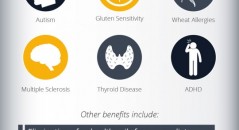Mindful Eating is the practice of bringing more attention and focus to eating. Mindful eaters take special care to notice their hunger cues before, during and after a meal. Mindful eating also requires its devotees to savor the sensory experience of eating by reflecting on the taste, appearance, texture, and smell of their food.
Above all else the goal of mindful eating is to avoid mindless, distracted eating habits. In a review of 24 studies researchers found that eating while distracted caused study participants to eat more than they would eat if they had dined without distraction.
The Benefits of mindful eating:
Mindful eating slows down your consumption which can help you avoid overeating. It takes about 20 minutes for the brain to register that you’re full. By slowing the pace of a meal you give your brain a chance to recognize that you’re satiated.
Mindful eaters get more pleasure from their meal. Enjoyment is enhanced when you focus on the experience of eating instead of allowing yourself to become distracted.
Research suggests that mindful eating could reduce stress. A group of obese study participants experienced significantly lower cortisol levels (a hormone associated with stress) and decreased anxiety when they practiced mindful eating.
When you are engaged in the practice of mindful eating, you are less likely to eat in response to emotional triggers.
Studies have shown that incorporating mindfulness into your daily habits can aid in weight loss.
Mindful eating is a discipline that can be learned. It is a deceptively simple concept that can be difficult to put into practice. In fact, Buddhist monks spend years working on this discipline. You can start the practice of mindful eating today by simply embracing one or two of the ten habits listed below.
10 ways to start eating mindfully
- Prior to sitting down for a meal reflect on your hunger level and emotional state. If you discover you are not hungry move on to another activity like meditation or taking a walk.
- Disengage from outside distractions while eating. Turn off the TV, your computer, and smart phone. Don’t eat while driving or doing another activity- simply eat.
- Eat at the table and consider decorating your dining space with flowers or candles. Formalizing your eating environment will encourage you to pay attention to the process of eating.
- Eat from a plate or bowl, not a bag. By placing your food out on a plate you will get a visual cue as to how much you are eating.
- Put your utensils down in between bites. If you have food in your mouth your hands should be empty. Take a moment to taste, chew and swallow each bite before taking the next.
- Chew your food 25 times before swallowing. Actually, you can pick any number of chews you like. The important thing is to make conscious effort to chew a certain number of times.
- Try to identify each ingredient in a dish. As you eat focus on flavor and take note of what spices and ingredients are present in each bite.
- Set a timer for 20 minutes and pace you meal so that you are eating till you hear the bell.
- Throughout your meal contemplate how your food got to your plate; think about how you cooked it, where you bought it, and the farmer who grew your ingredients.
- Eat with chop sticks or with your non-dominant hand. Simply by making the physical act of eating more challenging will bring awareness to your dining experience.








